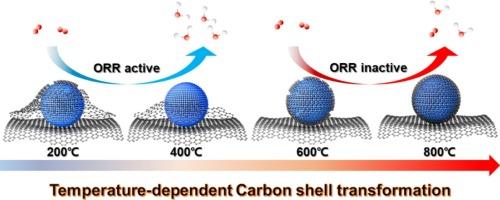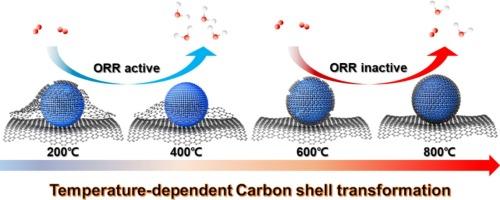Temperature-dependent carbon shell engineering for highly durable Pt@C catalysts in the oxygen reduction reaction
IF 6.9
2区 材料科学
Q2 CHEMISTRY, PHYSICAL
引用次数: 0
Abstract
In this study, we developed a straightforward and scalable all-dry synthetic process for carbon shell-encapsulated Pt catalysts (Pt@C/C) and analyzed the morphological evolution of the carbon shell at various heat-treatment temperatures. We investigated the impact of these morphological changes on the catalytic activity and durability for the oxygen reduction reaction (ORR). The synthesis process involved ball-milling Pt(acac)2 and carbon black, followed by heat treatment under nitrogen at 200–800 °C. The resulting Pt@C/C samples exhibited an ultrathin carbon shell thickness of less than 1 nm and Pt nanoparticles (2–4 nm) uniformly dispersed on the carbon support. In-situ heating transmission electron microscopy revealed critical morphological transitions: thin amorphous carbon shells (<1 nm) at 200 °C, partial shell decomposition at 400 °C, and dense graphene layers (1–2 layers) at temperatures ≥ 600 °C. Pt@C/C samples prepared at 200 and 400 °C exhibited superior mass and specific ORR activities compared to Pt/C, attributed to the uniform size of Pt nanoparticles and the carbon shell mitigating ionomer poisoning. The carbon shells maintained integrity during 30,000 cycles of accelerated stress test, minimizing Pt particle growth and ensuring superior durability over Pt/C. This method eliminates the need for high temperatures (>600 °C) and additional etching, achieving outstanding catalytic activity and durability at temperatures ≤ 400 °C.


温度依赖性碳壳工程用于高耐用Pt@C氧还原反应催化剂
在本研究中,我们开发了一种简单且可扩展的碳壳封装Pt催化剂(Pt@C/C)的全干合成工艺,并分析了碳壳在不同热处理温度下的形态演变。我们研究了这些形态变化对氧还原反应(ORR)的催化活性和耐久性的影响。合成工艺为球磨Pt(acac)2和炭黑,然后在200-800 °C氮气下热处理。所得Pt@C/C样品具有小于1 nm的超薄碳壳厚度和均匀分布在碳载体上的铂纳米颗粒(2 ~ 4 nm)。原位加热透射电子显微镜显示了关键的形态转变:在200 °C时,薄的无定形碳壳(<1 nm),在400 °C时,部分壳分解,在 ≥ 600 °C时,致密的石墨烯层(1 - 2层)。与Pt/C相比,在200和400 °C下制备的Pt@C/C样品表现出更好的质量和比ORR活性,这是由于Pt纳米颗粒的均匀尺寸和碳壳减轻了离子单体中毒。碳壳在30,000次加速应力测试中保持完整性,最大限度地减少了Pt颗粒的生长,并确保了比Pt/C更高的耐久性。该方法消除了高温(>600 °C)和额外蚀刻的需要,在 ≤ 400 °C的温度下实现了出色的催化活性和耐久性。
本文章由计算机程序翻译,如有差异,请以英文原文为准。
求助全文
约1分钟内获得全文
求助全文
来源期刊

Applied Surface Science
工程技术-材料科学:膜
CiteScore
12.50
自引率
7.50%
发文量
3393
审稿时长
67 days
期刊介绍:
Applied Surface Science covers topics contributing to a better understanding of surfaces, interfaces, nanostructures and their applications. The journal is concerned with scientific research on the atomic and molecular level of material properties determined with specific surface analytical techniques and/or computational methods, as well as the processing of such structures.
 求助内容:
求助内容: 应助结果提醒方式:
应助结果提醒方式:


